
- •Preface
- •Introduction
- •Lesson Objectives
- •Lesson Agenda
- •Course Objectives
- •Course Agenda
- •Appendixes Used in the Course
- •Lesson Agenda
- •Oracle Database 11g: Focus Areas
- •Oracle Database 11g
- •Oracle Fusion Middleware
- •Oracle Enterprise Manager Grid Control 10g
- •Oracle BI Publisher
- •Lesson Agenda
- •Relational and Object Relational Database Management Systems
- •Data Storage on Different Media
- •Relational Database Concept
- •Definition of a Relational Database
- •Data Models
- •Entity Relationship Model
- •Relating Multiple Tables
- •Relational Database Terminology
- •Lesson Agenda
- •Using SQL to Query Your Database
- •SQL Statements
- •Development Environments for SQL
- •Lesson Agenda
- •The Human Resources (HR) Schema
- •Tables Used in the Course
- •Lesson Agenda
- •Oracle Database 11g Documentation
- •Additional Resources
- •Summary
- •Practice I: Overview
- •Objectives
- •Lesson Agenda
- •Capabilities of SQL SELECT Statements
- •Basic SELECT Statement
- •Selecting All Columns
- •Selecting Specific Columns
- •Writing SQL Statements
- •Column Heading Defaults
- •Lesson Agenda
- •Arithmetic Expressions
- •Using Arithmetic Operators
- •Operator Precedence
- •Defining a Null Value
- •Null Values in Arithmetic Expressions
- •Lesson Agenda
- •Defining a Column Alias
- •Using Column Aliases
- •Lesson Agenda
- •Concatenation Operator
- •Literal Character Strings
- •Using Literal Character Strings
- •Alternative Quote (q) Operator
- •Duplicate Rows
- •Lesson Agenda
- •Displaying the Table Structure
- •Using the DESCRIBE Command
- •Quiz
- •Summary
- •Practice 1: Overview
- •Objectives
- •Lesson Agenda
- •Limiting Rows Using a Selection
- •Limiting the Rows That Are Selected
- •Using the WHERE Clause
- •Character Strings and Dates
- •Comparison Operators
- •Using Comparison Operators
- •Range Conditions Using the BETWEEN Operator
- •Membership Condition Using the IN Operator
- •Pattern Matching Using the LIKE Operator
- •Combining Wildcard Characters
- •Using the NULL Conditions
- •Defining Conditions Using the Logical Operators
- •Using the AND Operator
- •Using the OR Operator
- •Using the NOT Operator
- •Lesson Agenda
- •Rules of Precedence
- •Lesson Agenda
- •Using the ORDER BY Clause
- •Sorting
- •Lesson Agenda
- •Substitution Variables
- •Using the Single-Ampersand Substitution Variable
- •Character and Date Values with Substitution Variables
- •Specifying Column Names, Expressions, and Text
- •Using the Double-Ampersand Substitution Variable
- •Lesson Agenda
- •Using the DEFINE Command
- •Using the VERIFY Command
- •Quiz
- •Summary
- •Practice 2: Overview
- •Objectives
- •Lesson Agenda
- •SQL Functions
- •Two Types of SQL Functions
- •Single-Row Functions
- •Lesson Agenda
- •Character Functions
- •Case-Conversion Functions
- •Using Case-Conversion Functions
- •Character-Manipulation Functions
- •Using the Character-Manipulation Functions
- •Lesson Agenda
- •Number Functions
- •Using the ROUND Function
- •Using the TRUNC Function
- •Using the MOD Function
- •Lesson Agenda
- •Working with Dates
- •RR Date Format
- •Using the SYSDATE Function
- •Arithmetic with Dates
- •Using Arithmetic Operators with Dates
- •Lesson Agenda
- •Date-Manipulation Functions
- •Using Date Functions
- •Using ROUND and TRUNC Functions with Dates
- •Quiz
- •Summary
- •Practice 3: Overview
- •Objectives
- •Lesson Agenda
- •Conversion Functions
- •Implicit Data Type Conversion
- •Explicit Data Type Conversion
- •Lesson Agenda
- •Using the TO_CHAR Function with Dates
- •Elements of the Date Format Model
- •Using the TO_CHAR Function with Dates
- •Using the TO_CHAR Function with Numbers
- •Using the TO_NUMBER and TO_DATE Functions
- •Using the TO_CHAR and TO_DATE Function with RR Date Format
- •Lesson Agenda
- •Nesting Functions
- •Lesson Agenda
- •General Functions
- •NVL Function
- •Using the NVL Function
- •Using the NVL2 Function
- •Using the NULLIF Function
- •Using the COALESCE Function
- •Lesson Agenda
- •Conditional Expressions
- •CASE Expression
- •Using the CASE Expression
- •DECODE Function
- •Using the DECODE Function
- •Quiz
- •Summary
- •Practice 4: Overview
- •Objectives
- •Lesson Agenda
- •What Are Group Functions?
- •Types of Group Functions
- •Group Functions: Syntax
- •Using the AVG and SUM Functions
- •Using the MIN and MAX Functions
- •Using the COUNT Function
- •Using the DISTINCT Keyword
- •Group Functions and Null Values
- •Lesson Agenda
- •Creating Groups of Data
- •Creating Groups of Data: GROUP BY Clause Syntax
- •Using the GROUP BY Clause
- •Grouping by More than One Column
- •Using the GROUP BY Clause on Multiple Columns
- •Illegal Queries Using Group Functions
- •Restricting Group Results
- •Restricting Group Results with the HAVING Clause
- •Using the HAVING Clause
- •Lesson Agenda
- •Nesting Group Functions
- •Quiz
- •Summary
- •Practice 5: Overview
- •Objectives
- •Lesson Agenda
- •Types of Joins
- •Joining Tables Using SQL:1999 Syntax
- •Qualifying Ambiguous Column Names
- •Lesson Agenda
- •Creating Natural Joins
- •Retrieving Records with Natural Joins
- •Creating Joins with the USING Clause
- •Joining Column Names
- •Retrieving Records with the USING Clause
- •Using Table Aliases with the USING Clause
- •Creating Joins with the ON Clause
- •Retrieving Records with the ON Clause
- •Creating Three-Way Joins with the ON Clause
- •Applying Additional Conditions to a Join
- •Lesson Agenda
- •Joining a Table to Itself
- •Self-Joins Using the ON Clause
- •Lesson Agenda
- •Nonequijoins
- •Retrieving Records with Nonequijoins
- •Lesson Agenda
- •INNER Versus OUTER Joins
- •LEFT OUTER JOIN
- •RIGHT OUTER JOIN
- •FULL OUTER JOIN
- •Lesson Agenda
- •Cartesian Products
- •Generating a Cartesian Product
- •Creating Cross Joins
- •Quiz
- •Summary
- •Practice 6: Overview
- •Objectives
- •Lesson Agenda
- •Using a Subquery to Solve a Problem
- •Subquery Syntax
- •Using a Subquery
- •Guidelines for Using Subqueries
- •Types of Subqueries
- •Lesson Agenda
- •Single-Row Subqueries
- •Executing Single-Row Subqueries
- •Using Group Functions in a Subquery
- •The HAVING Clause with Subqueries
- •What Is Wrong with This Statement?
- •No Rows Returned by the Inner Query
- •Lesson Agenda
- •Multiple-Row Subqueries
- •Lesson Agenda
- •Null Values in a Subquery
- •Quiz
- •Summary
- •Practice 7: Overview
- •Objectives
- •Lesson Agenda
- •Set Operators
- •Set Operator Guidelines
- •The Oracle Server and Set Operators
- •Lesson Agenda
- •Tables Used in This Lesson
- •Lesson Agenda
- •UNION Operator
- •Using the UNION Operator
- •UNION ALL Operator
- •Using the UNION ALL Operator
- •Lesson Agenda
- •INTERSECT Operator
- •Using the INTERSECT Operator
- •Lesson Agenda
- •MINUS Operator
- •Using the MINUS Operator
- •Lesson Agenda
- •Matching the SELECT Statements
- •Matching the SELECT Statement: Example
- •Lesson Agenda
- •Using the ORDER BY Clause in Set Operations
- •Quiz
- •Summary
- •Practice 8: Overview
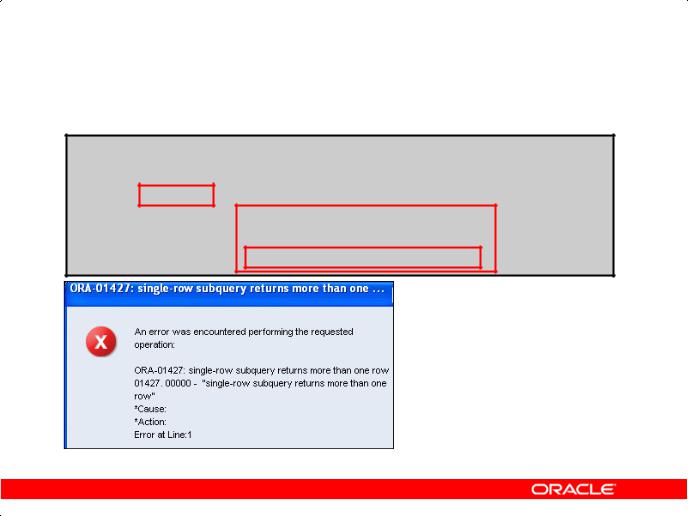
What Is Wrong with This Statement?
SELECT employee_id, last_name
FROM employees
WHERE salary =
(SELECT MIN(salary) FROM employees GROUP BY department_id);
Single-row operator with multiple-row subquery
Copyright © 2009, Oracle. All rights reserved. |
Academy |
|
What Is Wrong with This Statement? |
|
|
A common error with subqueries occurs when more than one row is r turned for a single-row |
||
subquery. |
Oracle |
|
|
||
In the SQL statement in the slide, the subquery contains GROUP BY clause, which implies that the
subquery will return multiple rows, one for each group that it finds. In this case, the results of the subquery are 4400, 6000, 2500, 4200,&7000, 17000Only, and 8300.
The outer query takes those results and uses them in its WHERE clause. The WHERE clause contains an equal (=) operator,Internala single-row comp rison operator that expects only one value. The = operator cannot accept more than one value from the ubqu ry and, therefore, generates the error.
To correct this error, change the = operator to IN. Oracle Use
Oracle Database 11g: SQL Fundamentals I 7 - 14
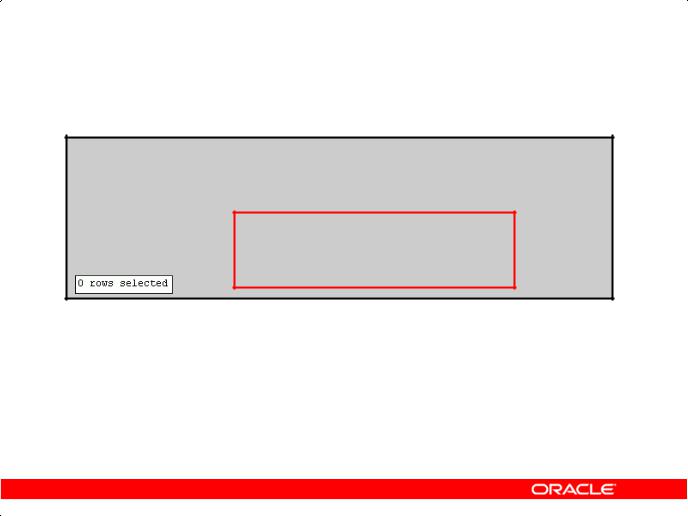
No Rows Returned by the Inner Query
SELECT last_name, job_id
FROM employees
WHERE job_id =
(SELECT job_id FROM employees
WHERE last_name = 'Haas');
Subquery returns no rows because there is no employee named “Haas.”
Academy A common problem with subqueries occurs whenOracleno rows are return d by the inner query.
In the SQL statement in the slide, the subquery contains WHERE clause. Presumably, the intention is to find the employee whose name is Haas. The statement is correct, but selects no rows when executed.
Because, there is no employee named Haas. So the subquery returns no rows. The outer query takes |
|
the results of the subquery (null) and uses &these results in its WHERE clause. The outer query finds no |
|
Internal |
|
employee with a job ID equal to null, nd so returnsOnlyno rows. If a job existed with a value of null, the |
|
|
Use |
row is not returned because comparison of two null values yields a null; therefore, the WHERE |
|
condition is not true. |
|
Oracle |
|
Oracle Database 11g: SQL Fundamentals I 7 - 15

Lesson Agenda
•Subquery: Types, syntax, and guidelines
•Single-row subqueries:
–Group functions in a subquery
–HAVING clause with subqueries
•Multiple-row subqueries
–Use ALL or ANY operator
•Null values in a subquery
|
Copyright © 2009, Oracle. All rights reserved. |
Academy |
||
|
|
|||
|
|
Oracle |
||
& |
Only |
|
||
|
Internal |
|
|
|
|
Use |
|
||
Oracle |
|
|
|
|
Oracle Database 11g: SQL Fundamentals I 7 - 16
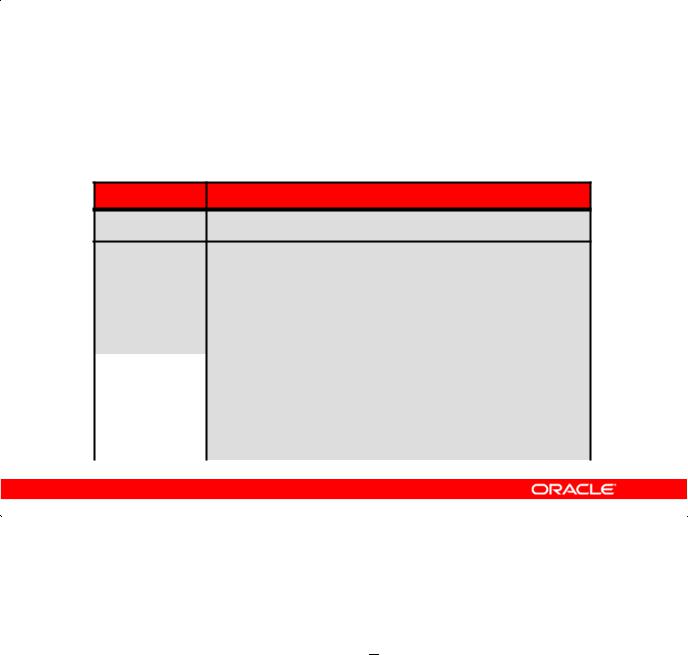
Multiple-Row Subqueries
•Return more than one row
•Use multiple-row comparison operators
Meaning
Equal to any member in the list
Must be preceded by =, !=, >, <, <=, >=. Compares a value to each value in a list or returned by a query. Evaluates to FALSE if the
|
|
query returns no rows. |
|
|
|
|
|
|
|
|
|
|
|
|
|
|
|
|
|
|
|
|
ALL |
Must be preceded by |
= != |
, |
> |
, |
< |
|
<= >= |
|
|
|
, |
|
|
, , . |
|
||||
|
|
Compares a value to every value in a list or |
|
|||||||
|
|
returned by a query. Evaluates to TRUE if the |
|
|||||||
|
|
query returns no rows. |
|
|
|
|
|
|
|
|
|
|
|
|
|
||||||
|
|
Copyright © 2009, Oracle. All rights reserved. |
Academy |
|||||||
Multiple-Row Subqueries |
|
|
|
|
|
|
|
|||
Subqueries that return more than one row are calledOraclemultiple-row subqueries. You use a multiple-row
operator, instead of a single-row operator, with a multiple-row subquery. The multiple-row operator
expects one or more values:
SELECT |
|
Only |
last_name, salary, department id |
||
FROM |
employees |
MIN(salary)& |
WHERE |
salary IN (SELECT |
|
The inner query is Internalexecuted first, producing a query result. The main query block is then processed |
||
|
FROM |
employees |
|
GROUP BY departm nt_id); |
|
Example: |
|
|
Find the employees who earn the sameUsesalary as the minimum salary for each department. |
||
Oracle |
|
|
and uses the va u s that were returned by the inner query to complete its search condition. In fact, the |
||
main query appears to the Oracle server as follows: |
||
SELECT |
last_name, salary, department_id |
|
FROM |
employees |
|
WHERE |
salary IN (2500, 4200, 4400, 6000, 7000, 8300, |
|
8600, |
17000); |
|
Oracle Database 11g: SQL Fundamentals I 7 - 17
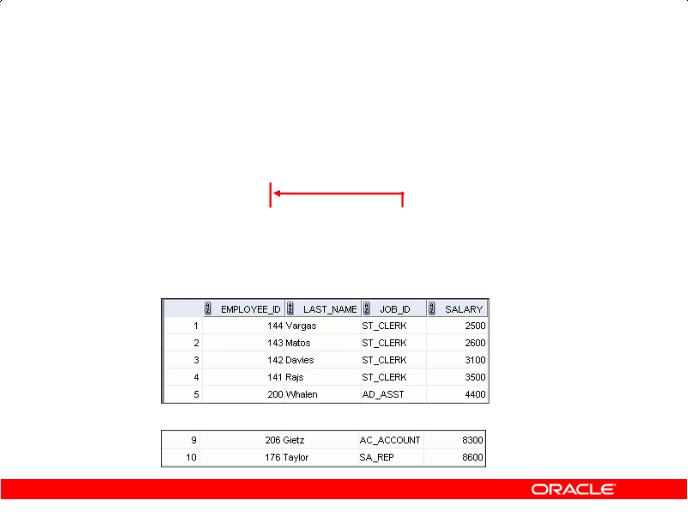
|
|
|
|
|
|
|
|
|
|
|
|
|
|
|
|
|
|
FROM |
employees |
|
|
|
|
|
WHERE |
job_id = 'IT_PROG') |
|
AND |
job_id <> 'IT |
_PROG'; |
|
|
||
|
|
|
|
|
|
|
|
… |
Academy |
|
Copyright © 2009, Oracle. All rights reserved. |
|
|
|
|
Using the ANY Operator in Multiple-Row Subqueries |
|
|
|
Oracle |
|
The ANY operator (and its synonym, the SOME operator) compar s a value to each value returned by a subquery. The slide example displays employees who are not IT programmers and whose salary is less than that of any IT programmer. The maximum sal y th t a programmer earns is $9,000.
<ANY means less than the maximum. >ANY means more than the minimum. =ANY is equivalent to |
||
IN. |
& |
Only |
|
||
|
|
|
Internal |
|
|
Oracle |
Use |
|
|
|
|
Oracle Database 11g: SQL Fundamentals I 7 - 18
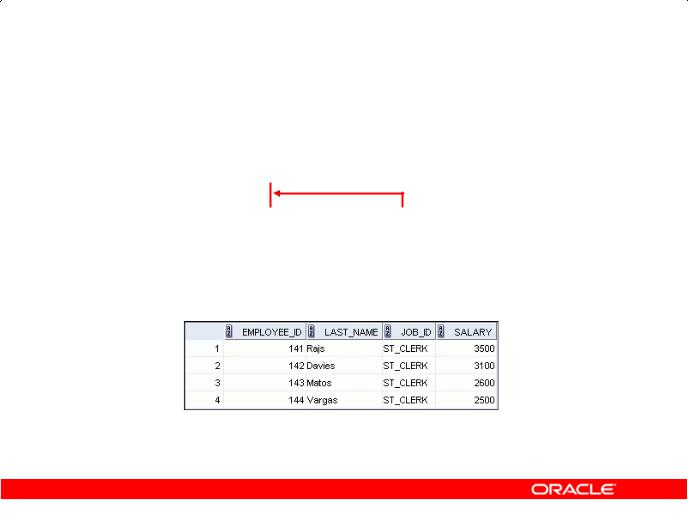
|
|
|
|
|
|
|
|
|
|
|
|
|
|
|
|
|
|
FROM |
employees |
|
|
|
|
|
WHERE |
job_id = 'IT_PROG') |
|
AND |
job_id <> 'IT |
_PROG'; |
|
|
||
|
|
|
|
|
|
|
|
Copyright © 2009, Oracle. All rights reserved. |
Academy |
|
|
|
Using the ALL Operator in Multiple-Row Subqueries |
|
|
|
Oracle |
|
|
The ALL operator compares a value to every value returned by a subquery. The example in the slide |
|
displays employees whose salary is less than the salary of all employees with a job ID of IT_PROG |
|
and whose job is not IT_PROG. |
|
>ALL means more than the maximum and <ALL means less than the minimum. |
|
& |
Only |
The NOT operator can be used with IN, ANY, and ALL operators. |
|
Internal |
|
Use |
|
Oracle |
|
Oracle Database 11g: SQL Fundamentals I 7 - 19
